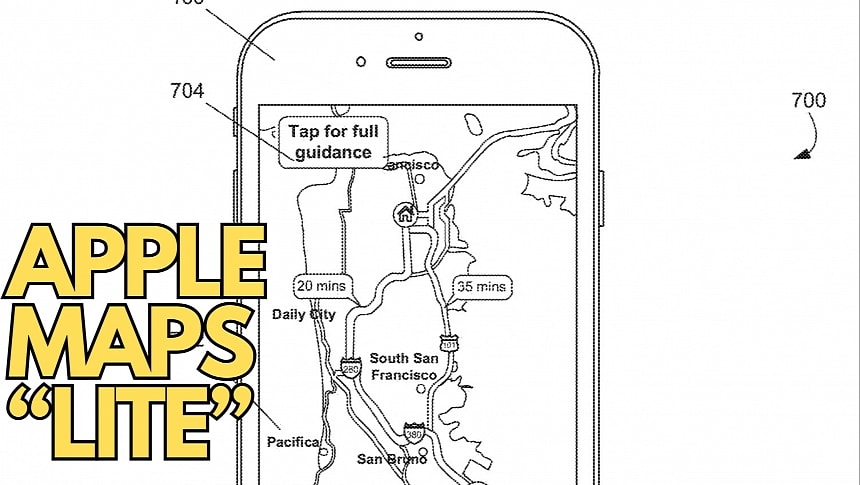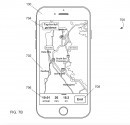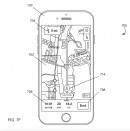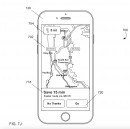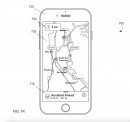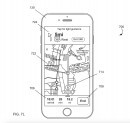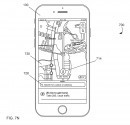We've known for a while that Apple wants to turn Apple Maps into a more advanced mapping platform, and while I don't think the company can reach the app's full potential without an Android version, it's no secret that the product progresses substantially.
The detailed city experience is a major overhaul of Apple Maps, bringing first-party maps with rich details, including crosswalks, sidewalks, and medians, and new capabilities like incident reporting and improved navigation.
However, now that the Apple Car project has been dropped, investing in Apple Maps is Apple's only way to remain relevant in the automotive space.
A recent patent, which describes a way to "provide light navigation guidance," describes how Apple Maps would offer a less-intrusive experience on the mobile device while also customizing the user interface according to how familiar a user is with a given route.
It all starts with Apple Maps proactively determining a destination. The iPhone maker explains that Apple Maps would be able to guesstimate where you plan to go based on previous routes, time of travel, and frequent destinations. Other navigation apps already do this based on similar factors, but Apple Maps would improve the experience by looking for traffic information.
Once the traffic information is obtained, the new technology kicks in. Apple explains that some routes could be flagged as "non-recommended," most often based on the traffic you are expected to encounter. Apple Maps would run a complex algorithm to rank routes and eventually decide which one to recommend.
One important factor in this algorithm is how familiar you are with a certain route.
Apple explains that a familiar route can be a previous route that you used on another occasion. The proposed technology would adjust its interface based on this analysis, so if you use a familiar route, you'll see a simplified interface with fewer instructions and less detailed guidance for heading to the destination.
Apple's reasoning makes sense. Given that you're already familiar with the route, mainly because you used it in the past, you don't need detailed turn-by-turn guidance to arrive at the destination. You'll still see the upcoming turns highlighted on the map, but Apple says it'll offer "less extensive information" in a "tailored navigation information" screen.
Users who drive to a non-familiar destination will get the "complete information," meaning they'll receive additional turn-by-turn guidance to make the experience more convenient.
Another important component of this patent is the experience with Apple Maps when it's not running on the screen.
Apple explains that the recommended routes can be displayed to the user on their iPhone even if the app isn't running. The user can receive the recommended route as a notification on the lock screen and decide if they use it for navigation.
In some scenarios, Apple can even offer " tailored navigation information even if the user does not open a map application." This means you can navigate with Apple Maps without the app in focus, still getting less extensive information when you begin driving to the destination.
Apple Maps already offers directions on the lock screen and in the Dynamic Island on the latest-generation iPhones, but the patent proposes a personalized experience based on how familiar users are with the recommended route.
The patent describes how Apple Maps would rank routes and decide if a user is familiar with a route, and if you're interested in all technical bits, I recommend you to read the document in full by downloading the PDF embedded below.
I'm almost certain Apple originally planned this technology to be part of the Apple Car experience, as the company wanted to seamlessly transfer route information from the mobile device to the vehicle via the Apple account. This seamless transfer is still possible even without an Apple Car, as the routes can migrate from the mobile device to CarPlay for straightforward navigation.
The demise of the Apple Car means Apple must go all-in on Apple Maps and CarPlay, as embracing a software strategy is the only option considering the failure of the self-driving vehicle. The approach is similar to Google's, as the search giant's automotive strategy centers around Android Auto, Android Automotive, and Google Automotive Services.
However, the death of the Apple Car doesn't mean Apple wasted $10 billion (the estimated spending since the company started the work on the vehicle in 2014). Apple filed thousands of patents related to the Apple Car, many of which were tied to Apple Maps and CarPlay, so it could pursue some ideas and bring them to production even without a first-party vehicle.
This new-generation version of Apple Maps is still in development, and the patent is no guarantee that Apple will bring this idea to mass production. However, it won't take long before we learn more about Apple's directions in the automotive space, especially as WWDC 2024 is already on the radar, and the company is expected to share more specifics about the future of its automotive ambitions.
However, now that the Apple Car project has been dropped, investing in Apple Maps is Apple's only way to remain relevant in the automotive space.
A recent patent, which describes a way to "provide light navigation guidance," describes how Apple Maps would offer a less-intrusive experience on the mobile device while also customizing the user interface according to how familiar a user is with a given route.
It all starts with Apple Maps proactively determining a destination. The iPhone maker explains that Apple Maps would be able to guesstimate where you plan to go based on previous routes, time of travel, and frequent destinations. Other navigation apps already do this based on similar factors, but Apple Maps would improve the experience by looking for traffic information.
Once the traffic information is obtained, the new technology kicks in. Apple explains that some routes could be flagged as "non-recommended," most often based on the traffic you are expected to encounter. Apple Maps would run a complex algorithm to rank routes and eventually decide which one to recommend.
One important factor in this algorithm is how familiar you are with a certain route.
Apple's reasoning makes sense. Given that you're already familiar with the route, mainly because you used it in the past, you don't need detailed turn-by-turn guidance to arrive at the destination. You'll still see the upcoming turns highlighted on the map, but Apple says it'll offer "less extensive information" in a "tailored navigation information" screen.
Users who drive to a non-familiar destination will get the "complete information," meaning they'll receive additional turn-by-turn guidance to make the experience more convenient.
Another important component of this patent is the experience with Apple Maps when it's not running on the screen.
In some scenarios, Apple can even offer " tailored navigation information even if the user does not open a map application." This means you can navigate with Apple Maps without the app in focus, still getting less extensive information when you begin driving to the destination.
Apple Maps already offers directions on the lock screen and in the Dynamic Island on the latest-generation iPhones, but the patent proposes a personalized experience based on how familiar users are with the recommended route.
The patent describes how Apple Maps would rank routes and decide if a user is familiar with a route, and if you're interested in all technical bits, I recommend you to read the document in full by downloading the PDF embedded below.
The demise of the Apple Car means Apple must go all-in on Apple Maps and CarPlay, as embracing a software strategy is the only option considering the failure of the self-driving vehicle. The approach is similar to Google's, as the search giant's automotive strategy centers around Android Auto, Android Automotive, and Google Automotive Services.
However, the death of the Apple Car doesn't mean Apple wasted $10 billion (the estimated spending since the company started the work on the vehicle in 2014). Apple filed thousands of patents related to the Apple Car, many of which were tied to Apple Maps and CarPlay, so it could pursue some ideas and bring them to production even without a first-party vehicle.
